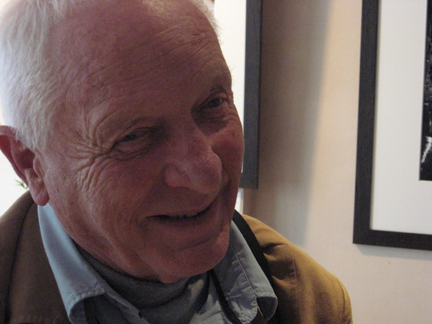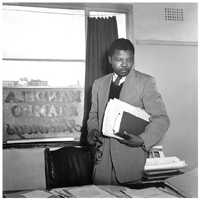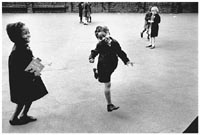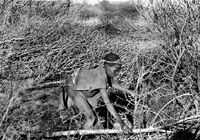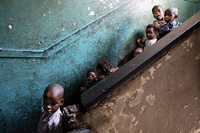Photographer Jurgen Schadeberg
by Daniel Brown
Article published on the 2009-06-14 Latest update 2009-08-28 13:36 TU
French-based photographer Jurgen Schadeberg has split his life between South Africa and Europe to offer the world iconic pictures that go from the elite to the anonymous. He and his wife/producer/partner Claudia have enjoyed a watershed year of exhibitions reflecting the photographer’s plunge into the worlds of politics, society and music.
Culture in France: Photographer Jürgen Schadeberg
In the intimate Paris boutique with the provocative name, Le Voleur d’Images, 78-year-old Jurgen Schadeberg was busy discussing the lay-out for an exhibition of his photos of the Berlin Wall, mainly shot in 1961. The German was in Paris this week to finalise the November 2009 exhibition and book which is to mark the 20th anniversary of the fall of the Wall.
“There was a tremendous, frightening tension in Berlin,” he explained to the designer as they pored over the black and white images. “The city was a focal point; any spark could start off a nuclear war. But life went on; people still went to the café for tea and coffee.”
The evocation of Cold War Berlin could well sum up the rollercoaster life of the photographer today based in the remote countryside of Normandy. Born in the German capital in 1931, Schadeberg survived the horrors of Nazi Germany (of which he talks very little) until he was 14.
He left his homeland to settle in South Africa in 1951. There he embarked on a remarkable career where he chronicled the apartheid years through his Leica camera. Quickly, he became Chief Photographer, Picture Editor and Art Director on Drum Magazine, a publication that became nigh-mythical for its coverage of the Defiance Campaign and the Sharpeville massacre.
Schadeberg photographed pivotal figures and moments in the lives of South Africans in that decade. This includes unique pictures of the likes of Nelson Mandela, Yusuf Dadoo, and Walter Sisulu.
On June 18th the Leica Gallery in Salzburg is honouring his monumental work with a month-long exhibition called “Timeless Moments”. This will display sixty photos from Schadeberg’s sixty year career. Surprisingly, it wasn’t so difficult for the sprightly photographer to choose them from the 100,000 negatives he has amassed in his career.
“The subject matter I choose reveals itself through the choice of space, how the images are framed and the situation you are in,” the septuagenarian explained with the gestures of a philharmonic conductor.
“Take this image,” he continued, pointing to a page in a coffee table retrospective on his life. “This was taken in a school playground in London. There are two black girls in uniforms. One is standing and laughing, there on the left, and holding a schoolbook called “Janet and Jon”. The other is running and jumping in the air, into space, she’s not touching the ground, and she’s smiling. They both look terribly happy. Well, this is a particular moment, it’s there, and it will never change, never move. But she keeps moving,” he underlined jabbing his finger at the girl in the air. “And if you keep on looking at her, she just keeps moving. For me, it’s a particular moment of happiness.”
At the same time as the Austrian exhibition, Arte Television has programmed an hour-long documentary, also spanning the photographer’s career. The July 2 broadcast by the French-German TV station of “Schadeberg Black and White” is part of a high-profile year for the veteran. The film title is misleading in that Schadeberg also shoots remarkable pictures in colour, as testified by his 2007 work Tales from Jozi But it does reflect his personal penchant for the former, a slightly nostalgic world replete with shades of black and a subtle play on lighting.
"I prefer black and white,” he states. “Maybe because it’s more abstract. It’s a strange and a difficult decision. To know when to shoot in black and white, and when to look at something in black and white. It requires a different way of seeing.”
Even if uneven, the film has some powerful and moving moments. Schadeberg catches up with some of his old friends from his militant years when he was twice arrested by the apartheid police. The post-apartheid years have not always been kind to those who sacrificed so much to overcome South Africa’s institutional racism. One couple the photographer talks to, however, have nothing but praise for what Schadeberg has contributed to the struggle.
"You have been the main social documentary photographer and historian of South Africa for over 50 years,” exclaims one, with no sign of obsequiousness. Schadeberg remains characteristically quiet and self-effacing in front of such effusion, and laughs nervously.
Culture
Cracking skulls!
2010-02-15 12:35 TU
France's gothic avant-garde
2010-02-13 15:16 TU
Winter sounds warm up French jazz fans
A tribute to trumpeter Don Cherry at a Free Jazz showcase festival outside of Paris.
2010-01-31 11:55 TU
Trance on a trapeze
2010-01-30 12:41 TU
Retro Mobile - classic car exhibition
260,500 euros for rusty old car found at bottom of lake
A rusty old Bugatti, which spent years at the bottom of a Swiss lake, sold for 260,500 euros at the Retro Mobile classic car exhibition on Saturday. Other more lovingly-restored pristine examples are exciting enthusiasts from across the world in a special anniversary event at Porte de Versailles in Paris.
2010-01-23 20:21 TU
France's changing face looks east
2010-01-22 16:17 TU
Putting art on film
2010-01-20 13:09 TU
What sex is a coffee bean, where does the aubergine come from?
2010-01-08 16:08 TU
Cocteau Twin flying solo
2010-01-06 16:43 TU
A taste of Nordic filmmaking in Paris
Ciné Nordica 2009 at Paris’s Panthéon cinema showcases filmmaking from Scandinavia. So what makes Nordic film different from the rest?
2009-12-22 17:15 TU




